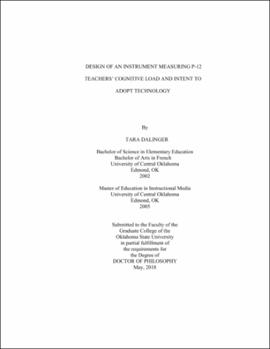| dc.contributor.advisor | Asino, Tutaleni I. | |
| dc.contributor.author | Dalinger, Tara | |
| dc.date.accessioned | 2023-04-26T16:20:28Z | |
| dc.date.available | 2023-04-26T16:20:28Z | |
| dc.date.issued | 2018-05 | |
| dc.identifier.uri | https://hdl.handle.net/11244/337479 | |
| dc.description.abstract | For P-12 teachers to effectively learn a technology, they must manage the cognitive load inherent to this learning task. Cognitive Load Theory (CLT) can offer insight in how P-12 teachers can manage the cognitive load of learning technology. However, technology adoption research has not used CLT to investigate how P-12 teachers manage the cognitive load of learning how to use technology or the influence of cognitive load on P-12 teachers’ decisions whether to adopt technology. Hence, an instrument measuring cognitive load experienced when P-12 teachers learn about technology during professional development and their intent to adopt the technology may not be available. The purpose of this study was to design a self-report survey instrument measuring the latent constructs of P-12 teachers’ cognitive load during technology professional development and their intent to adopt technology. Access to a validated instrument measuring these latent constructs may facilitate exploration of cognitive load’s influence on technology adoption among P-12 teachers. Diffusion of Innovations and Cognitive Load Theory formed the theoretical foundation of this study and the instrument’s design. The researcher conducted an index of item-objective congruence (IIOC) to evaluate content validity. Using data collected from P-12 teachers participating in technology professional development on the creation of interactive PowerPoint lessons, the researcher conducted exploratory factor analysis (EFA) to explore the factor model most representative of the data and to determine the instrument’s internal consistency and variance explained. Results of the IIOC indicated a lack of consensus among content judges on which forms of cognitive load are being measured. Results of EFA supported a two-factor model explaining 79.759 % of the variance in the observed data. Implications of this study for future research on cognitive load and technology adoption among P-12 teachers is discussed. | |
| dc.format | application/pdf | |
| dc.language | en_US | |
| dc.rights | Copyright is held by the author who has granted the Oklahoma State University Library the non-exclusive right to share this material in its institutional repository. Contact Digital Library Services at lib-dls@okstate.edu or 405-744-9161 for the permission policy on the use, reproduction or distribution of this material. | |
| dc.title | Design of an instrument measuring P-12 teachers’ cognitive load and intent to adopt technology | |
| dc.contributor.committeeMember | Stansberry, Susan | |
| dc.contributor.committeeMember | Thompson, Penny | |
| dc.contributor.committeeMember | Mwavita, Mwarumba | |
| dc.contributor.committeeMember | Chandrasekera, Tilanka R. | |
| osu.filename | Dalinger_okstate_0664D_15607.pdf | |
| osu.accesstype | Open Access | |
| dc.type.genre | Dissertation | |
| dc.type.material | Text | |
| dc.subject.keywords | cognitive load theory | |
| dc.subject.keywords | diffusion of innovations | |
| dc.subject.keywords | professional development | |
| dc.subject.keywords | technology adoption | |
| thesis.degree.discipline | Educational Technology | |
| thesis.degree.grantor | Oklahoma State University | |
